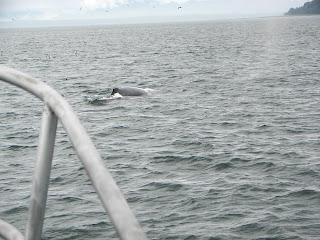After a send-off from our porpoise friends this morning, we headed towards Glacier Bay. Now, at the opening of the park there’s an area of a few square miles that they designate as whale waters. The guy that I talked to on the phone warned me that we needed to watch out for whales there, so I felt reasonably confident that we’d see a couple.
We saw a hundred, easily. I’ve never seen anything like it. Humpback whales in every direction. Here’s a picture off the bow sprit, so you can see how close they were.
But, check out this video. Credit to Kathy.
We were told that they smack their tales like that to get barnacles off, but really? Anyway, I think the video makes the whole scene a touch, I don’t know, sillier than it is in reality. Their movements out of the water actually feel quite slow and deliberate. But in any case you can get a sense for just how much activity there was. At one point, we saw a whale throw its entire body out of the water. Straight up in the air. Twice. Eventually we were in waters so thick with whales it looked like drifting through a sauna with the spray and residual mist from spouts rising off the water around us.
So, I’ve been developing a special photo technique. I used to wait for the right shot, but now when I hear a sound in the water, I turn towards it and click wildly. It seems to be working, a little bit. I’m going to start working on my video skills next, because one of the things that’s most impressive to me is the sounds. There’s something about standing on the deck of a slightly creaking sailboat listening to the whales breach and spout, the birds call, and the sea lions bark.
OK, about the whale waters…lots of species of baleen whales, humpbacks included, come north for the summer because plankton is plentiful in these waters. There are even more up in Antarctic waters. Then, during the winter, they migrate to tropical waters where conditions are ideal for calving. (Actually, the Sea of Cortez, where Dan and Kathy are headed next, is famous for being the calving spot for gray whales.) So right now they’re here eating, getting ready for the trip south.
On a sad note, it turns out humpback whales have a few characteristics that made them particularly susceptible to whaling: Their migration patterns are highly predictable, they swim slowly in coastal waters (rather than in deeper waters like blue whales, for instance), and they don’t flee from approaches. Their population dropped by over 90% worldwide, but their numbers are increasing again, back up to 80,000 worldwide from a pre-whaling population of bout 125,000.




It is certainly wise of Dan and Kathy to eat in Glacier Bay, getting ready for the trip south.
ReplyDeleteBon appetit!